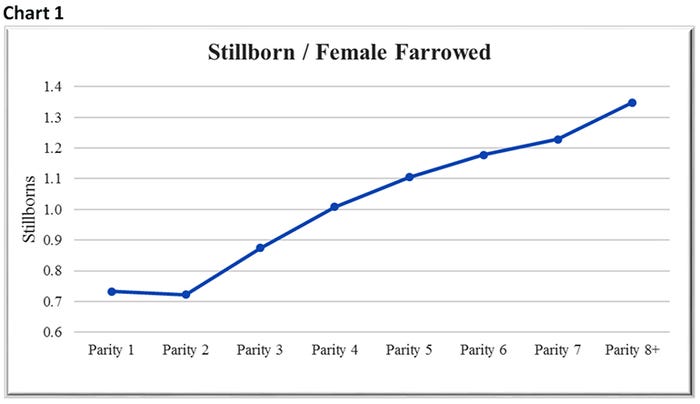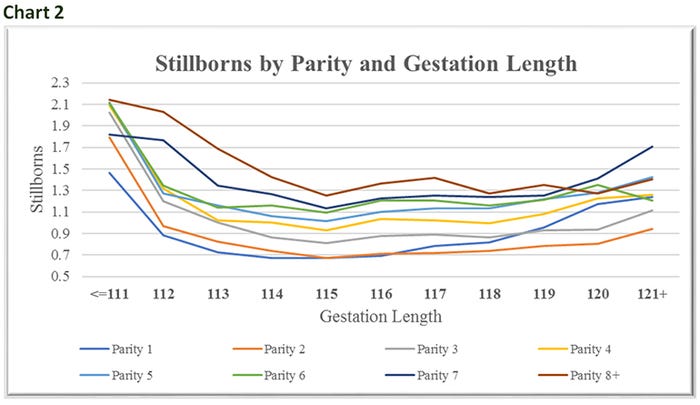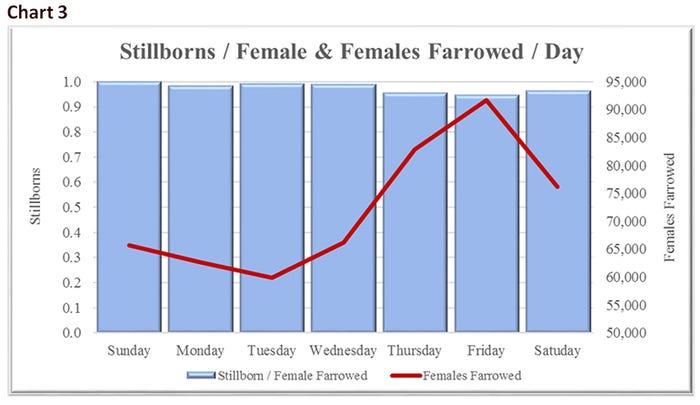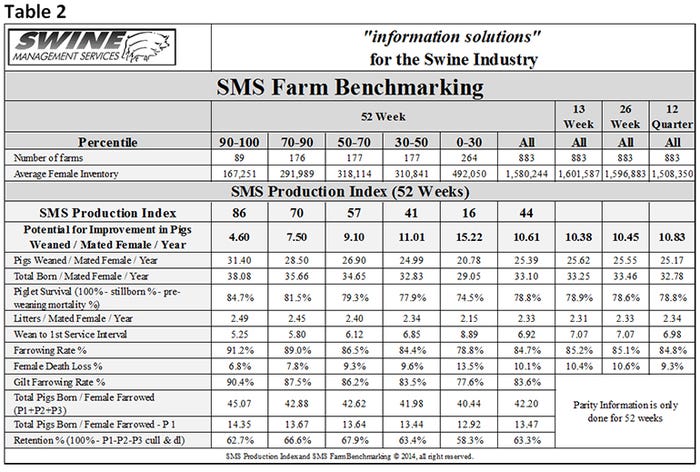While there isn’t a magic bullet, there is a common theme to reducing stillborns. It is trained people being in the farrowing rooms more than eight hours per day.

Stillborns sure can be frustrating and hard to figure out. Sometimes it doesn’t matter how much attention a sow is getting she still has a stillborn or even multiple. There are some things that we do know based on an analysis of 49 farms from our database that makes up 120,000 sows and 536,000 farrowing over the last three years. Data shows that 80% of the stillborns come from 20% of the sows so if we can identity and focus on those 20% of the sows then we will be able to reduce stillborns. So how do we help identity those sows?
As sows age, it is likely for them to tire more easily during the farrowing process and sometimes even quit pushing completely prior to the delivery of all the pigs. Sows with larger litters are even a larger problem. Chart 1 shows that the older the sow the more stillborns she is going to have. As a sow ages, the frequency of needing assistance increases and the time between assisting show be shortened.

In the data we reviewed, gestation length clearly plays a role in the number of stillborns. Chart 2 shows that for all parities those that farrow early and late have more stillborns, with 3.9% of the farrowings occurring at day 113 or less while 5.4% occurred at 119-plus days. While we can do little to help sows get to 114 days we can induce to prevent sows farrowing after 119 days.

What is the effect of inducing on day 114 when a sow’s natural gestation length is 116 days? This will probably cause an increase in stillborns and a decrease in piglet viability. If you induce a majority of your sows, try a couple of weeks without to see what their natural gestation length is. As total born has increased over the years so has natural gestation length.
Identifying high-risk sows and providing extra assistance is another way to help reduce stillborns. Table 1 shows a sow record, and starting as a gilt she has continually had multiple stillborns each litter. One way to provide extra assistance is by marking her card so that it can be seen from anywhere in the room noting that she is high-risk. Another way is to pen high-risk sows together in one area of each farrowing room, so staff knows to pay extra attention to those girls. Early in the farrowing process it may take up to 30 minutes between piglet arrivals but later in the farrowing process it should be no more than 20 minutes. Checking sows at a regular interval is key to reducing stillborns. The staff should also have staggered breaks to make sure that someone is keeping the schedule. A third way to assist this sow is to induce her to increase the chance of her farrowing while someone is there during the day if in fact you don’t have extended hours.

Speaking of extended farrowing hours, it has previously been said that the breeding crew would never leave for the day if there were still animals to be bred but why is it the farrowing crew leaves before the sows and pigs that they are in charge of caring for still need attention. When do most sows start farrowing on your farm? In several farms that we have tracked, most sows that are not induced start farrowing between 11 a.m. and 2 p.m. If she doesn’t start farrowing until 2 p.m., then the chances are pretty good that she won’t be finished by the time the farrowing staff leaves for the day. Having a farrowing attendant for 12 to 15 hours per day will allow 80%-plus of the farrowings to be attended. How many pigs per shift does a person need to save to justify extending farrowing hours on your farm? That could be less than three.
Having someone there from 3 p.m. to 11 p.m. with a very simple job description of getting the pigs out of the sow alive, drying them off, nipple training and making sure all pigs are getting colostrum will not only decrease the number of stillborns but also lower pre-weaning mortality. Chart 3 shows the number of farrowings per day on the same scale as stillborns per litter by day of the week. There are between 59,000 and 91,000 farrowings per day, showing that Thursday, Friday and Saturday are the biggest farrowing days equaling 50% of the farrowings those three days, leaving the other four days of the week having the other 50%. A total of 48.7% of the stillborns are occurring on those three days, so even when you are likely to have more staff focused assisting sows do you have enough? How many active labors can a staff member cover? We would suggest that number is between 12 and 15 depending on the genetics, number of pigs born, the size of pigs and the age of the herd.

While there isn’t a magic bullet, there is a common theme to reducing stillborns. It is trained people being in the farrowing rooms more than eight hours per day. Do you have enough trained people focused on reducing them?
Table 2 provides the 52-week rolling averages for 11 production numbers represented in the Swine Management Services Production Index. The numbers are separated by 90-100%, the 70-90%, the 50-70%, the 30-50%, and the 0-30% groups. We also included the 13-week, 26-week and 12-quarter averages. These numbers represent what we feel are the key production numbers to look at to evaluate the farm’s performance.

At SMS, our mission statement is to provide “Information solutions for the swine industry.” We feel with the creation of different SMS Benchmarking databases for all production areas we now have more detailed information to share with the swine industry.
If your farm would like to be part of the SMS Benchmarking databases, or if you have suggestions on production areas to write columns about, please email at [email protected], [email protected] or [email protected]. We enjoy being a part of the National Hog Farmer Weekly Preview team. Previous Production Preview columns can be found at NationalHogFarmer.com.
About the Author(s)
You May Also Like



